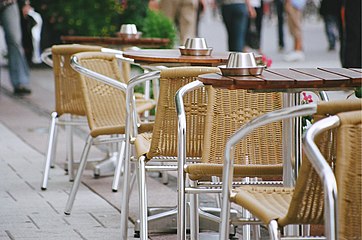
Rattan, also spelled ratan, is the name for roughly 600 species of Old World climbing palms belonging to subfamily Calamoideae. The greatest diversity of rattan palm species and genera are in the closed-canopy old-growth tropical forests of Southeast Asia, though they can also be found in other parts of tropical Asia and Africa. Most rattan palms are ecologically considered lianas due to their climbing habits, unlike other palm species. A few species also have tree-like or shrub-like habits.
Underwater basket weaving is an idiom referring pejoratively to supposedly useless or absurd college or university courses and often generally to refer to a perceived decline in educational standards.
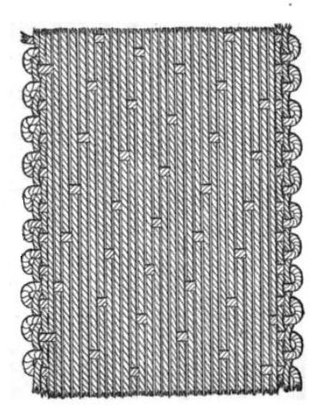
A satin weave is a type of fabric weave that produces a characteristically glossy, smooth or lustrous material, typically with a glossy top surface and a dull back; it is not durable, as it tends to snag. It is one of three fundamental types of textile weaves alongside plain weave and twill weave.

A basket is a container that is traditionally constructed from stiff fibers, and can be made from a range of materials, including wood splints, runners, and cane. While most baskets are made from plant materials, other materials such as horsehair, baleen, or metal wire can be used. Baskets are generally woven by hand. Some baskets are fitted with a lid, while others are left open on top.

In the context of furniture, caning is a method of weaving chair seats and other furniture, either while building new chairs or in the process of cane chair repair.

Charpai is a traditional woven bed used across South Asia. The name charpai is a compound of char “four” and pay “footed”. Regional variations are found in Afghanistan and Pakistan, North and Central India, Bihar and Myanmar.
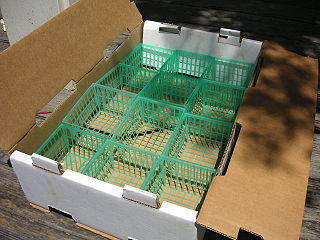
A punnet is a small box or square basket for the gathering, transport and sale of fruit and vegetables, typically for small berries susceptible to bruising, spoiling and squashing that are therefore best kept in small rigid containers. Punnets serve also as a rough measure for a quantity of irregular sized fruits.
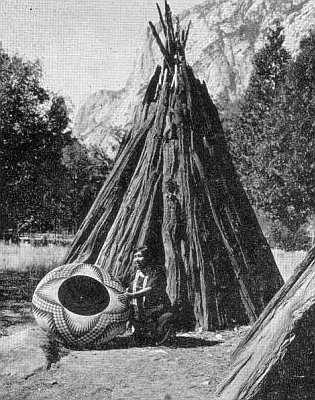
Basket weaving is the process of weaving or sewing pliable materials into three-dimensional artifacts, such as baskets, mats, mesh bags or even furniture. Craftspeople and artists specialized in making baskets may be known as basket makers and basket weavers. Basket weaving is also a rural craft.
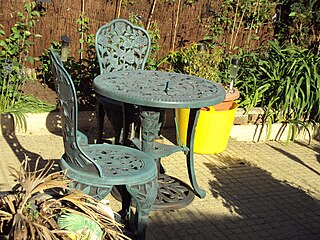
Garden furniture, also called patio furniture or outdoor furniture, is a type of furniture specifically designed for outdoor use. It is typically made of weather-resistant materials such as aluminium which is rust-proof.

In tableware the Osier pattern is a moulded basket-weave pattern in delicate relief used round the borders of porcelain plates and other pieces of flatware. It originated in Germany in the 1730s on Meissen porcelain, and was later often imitated by other producers. It is presumed to have been devised by Johann Joachim Kaendler, the celebrated head modeller at Meissen. The name comes from Salix viminalis, or the common osier, a Eurasian species of willow, whose thin, flexible, shoots or withies were and are much used for various types of wickerwork, usually encouraged by coppicing the plants.

Mike Dart is a Native American basket weaver and citizen of the Cherokee Nation, who lives in Oklahoma.

The Willows and Wetlands Visitor Centre is situated at Stoke St Gregory, on the Somerset Levels, north east of Taunton, England. Based on a working farm, growing and processing willow, the centre offers tours of over 80 acres (0.13 sq mi) of withies, willow yards and basket workshops and explains the place of willow in the history of the Levels.

A bed base, sometimes called a foundation, is the part of a bed that supports the mattress. The bed base can itself be held in place and framed by the bedstead. In the United States, box-spring bed bases are very common. In Europe, sprung slats are much more common.

Calamus rotang, also known as common rattan, is a plant species native to India, Sri Lanka and Myanmar (Burma). It is one of the scandent (climbing) rattan palms used to make Malacca cane furniture, baskets, walking-sticks, umbrellas, tables and general wickerwork, and is found in Southwest Asia. The basal section of the plant grows vertically for 10 metres or so, after which the slender, tough stem of a few centimetres in diameter, grows horizontally for 200 metres or more. It is extremely flexible and uniform in thickness, and frequently has sheaths and petioles armed with backward-facing spines which enable it to scramble over other plants. It has pinnate, alternate leaves, 60–80 cm long, armed with two rows of spines on the upper face.

The Wakefield Rattan Company was the world's leading manufacturer of rattan furniture and objects in the second half of the 19th century. Founded by Cyrus Wakefield in 1851 in South Reading, Massachusetts, it perfected machinery for working with rattan, developing looms for weaving chair seats and mats. Its products also included wicker furniture and baby carriages. The company also successfully found uses for previously wasted portions of the plant, using shavings to create baling fabric and floor coverings. Its products were available throughout the United States.
The Heywood-Wakefield Company is an American furniture manufacturer established in 1897. It went on to become a major presence in the US. Its older products are considered collectibles and have been featured on Antiques Roadshow.
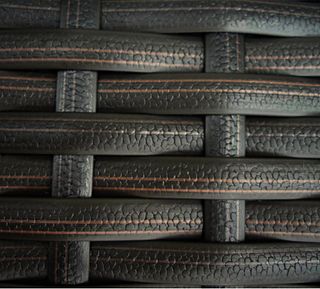
Resin wicker, also known as all-weather wicker, is a type of heavy-duty textile made from synthetic resin, such as polyethylene, and woven to imitate traditional wicker.

The Garden Egg chair was designed by Peter Ghyczy in 1968. It was manufactured by Reuter Products. The chair was designed for both indoor and outdoor use, although as a design icon and collectable it is rarely used outdoors. The chair lid lifts and closes, and when closed is theoretically waterproof. The Egg chair was re-introduced in 2001 by Ghyczy Novo. The Garden Egg Chair is known by several names; “seftenberger ei, pod chair, l’œuf en garden(egg)chair.” Elastogran/Reuter produced the plastic polyurethane. Ghyczy's job was to start a design centre in order to show industrial customers polyurethane's potential. The Garden Egg Chair is one of the first chairs made with polyurethane. For a long time, the chair was produced by the East German company VEB-Synthese-Werk, but since 1998, it has been produced in the Netherlands.

Ancient furniture was made from many different materials, including reeds, wood, stone, metals, straws, and ivory. It could also be decorated in many different ways. Sometimes furniture would be covered with upholstery, upholstery being padding, springs, webbing, and leather. Features which would mark the top of furniture, called finials, were common. To decorate furniture, contrasting pieces would be inserted into depressions in the furniture. This practice is called inlaying.
Bamboo weaving is a form of bambooworking and a traditional craft of Taiwan.








